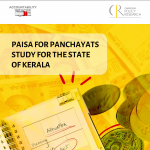
The Public Housing Sector – A Case Study of Karnataka
27 February 2017
Public Housing is a government service that garners a lot of attention, for several reasons. It is of course, an essential service and hugely important from the perspective of the poor. There are several such pro-poor services provided by the government, covering everything from health care to subsidised food, to crèches, schools and toilets. Housing stands apart from them, for two reasons.
First, Housing offers the largest per-capita subsidy offered to individuals or families as compared to other government programmes. There are other services such as guaranteed employment that might compete with housing in terms of the numbers of beneficiaries covered, but, due to the cap on the number of days of employment that are guaranteed under the present arrangements, the per capita subsidy levels are at best, about half the average subsidy delivered to each housing beneficiary. Other services, such as the provision of drip irrigation facilities, bore wells and farm mechanisation equipment to farmers may offer a larger per-beneficiary subsidy, but the might cover a few hundreds or thousands as compared to the provision of houses, where annual targets for an average State exceeds 2 lakh units.
Second, a house is a tangible, permanent asset. Construction can be visibly started on a particular day, and completion marked by a house warming ceremony. That provides much more opportunity to the person who claims ownership of the privilege for having ‘granted’ the house to the beneficiary, to bask in the gratefulness that the latter may shine on him. That link of the benefit to the large heartedness of the benefactor is not so tangible, say, in a programme for improving of educational outcomes.
For these two reasons, it is no surprise that politicians and officials compete with each other for assuming planning and execution responsibilities for delivering houses to beneficiaries. Whatever may be their actual role in the supply chain of providing houses, politicians and officials of all hues and levels like to be seen as the ones who swung the deal for beneficiaries; so they often fight amongst themselves for that privilege.
Then, there is the temptation of skimming off a good percentage from the expenditure incurred on housing. Since the subsidies on housing are high, most politicians and officials handling their allotment and construction reckon, quite correctly, that grateful beneficiaries will not be averse to generously parting with a share of the subsidy to them. Whilst cost estimates for constructing homes have to meet certain norms and standards, the actual material costs may greatly vary from official estimates, as recycling of old materials can reduce actual investments in housing. That adds to the cushion that might make beneficiaries more sanguine about parting with a share of the subsidies to the people who got them the house.
In short, the deal is simple; government officers and politicians who control the allocating and constructing of homes for people not only gain goodwill, but also stand to make a lot of money on the side.
Before one gets deeper into the dynamics of how subsidised housing is delivered, one must note that the systems and institutions in place for urban and rural housing respectively are different. We propose to focus on rural housing.
The process of delivering houses to the poor comprises essentially of two processes; namely, selection of beneficiaries and the actual construction of the homes. In my next blog, I will explore what are the accountability measures for the processes of selection of beneficiaries, and how they are diluted.





